Meet Our Available Puppies
Find the perfect ‘tail’ for your story!
The Puppy You've
Been Waiting For.
Product Title Here
Put a bird on it tumblr trust fund sustainable williamsburg green juice.
Product Title Here
Put a bird on it tumblr trust fund sustainable williamsburg green juice.
Product Title Here
Put a bird on it tumblr trust fund sustainable williamsburg green juice.
Product Title Here
Put a bird on it tumblr trust fund sustainable williamsburg green juice.
Product Title Here
Put a bird on it tumblr trust fund sustainable williamsburg green juice.
Product Title Here
Put a bird on it tumblr trust fund sustainable williamsburg green juice.
January 8, 2025
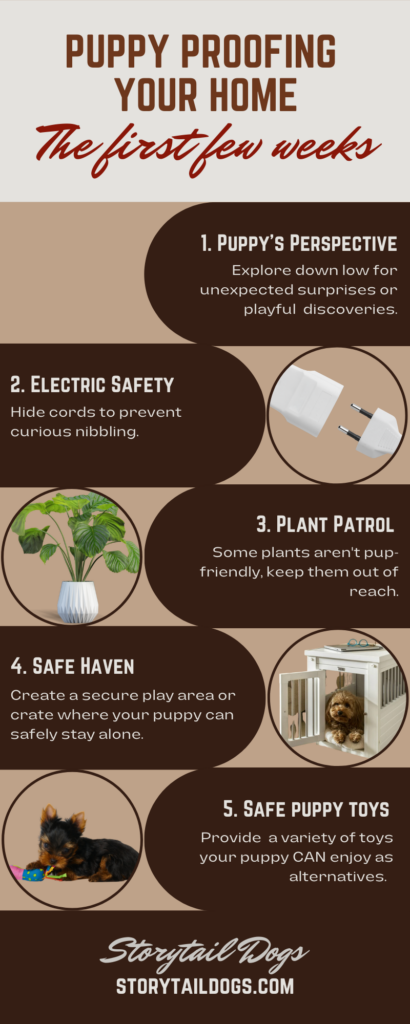
Welcoming a new puppy into your home is an exciting, joyful experience, but it also requires preparation and responsibility. Just like toddlers, cavapoo dogs are curious, energetic, and ready to explore every nook and cranny of their environment. However, unlike toddlers, puppies don’t always know what’s safe and what’s not. To ensure both your home and your new puppy are safe during the first few weeks together, it’s crucial to puppy-proof your space. This blog post will guide you step-by-step on how to make your home puppy-friendly, minimize accidents, and set your puppy up for a healthy, happy life.
1. Puppy-Proofing Starts with a Puppy-Safe Space
Your first step in puppy-proofing your home is creating a safe environment that allows your puppy to explore freely while reducing the risk of injury or mischief. A designated “puppy-safe space” is essential during the initial weeks as it limits your puppy’s access to unsafe areas while they adjust to their new home.
How to Create a Puppy-Safe Space for Cavapoo Dogs:
- Use Baby Gates: Install baby gates in doorways to keep your puppy away from certain rooms, such as the kitchen, bathroom, or laundry room. These areas can have hazards like cleaning supplies, sharp objects, or dangerous foods.
- Set Up a Crate or Playpen: A crate can be your puppy’s safe retreat when you’re not able to supervise them directly. Alternatively, a playpen can offer a larger, more comfortable space with boundaries that keep them from wandering into trouble.
Things to Keep in Mind:
- Ensure the space has comfortable bedding for naps and a few chew toys to keep your puppy entertained.
- Make sure the area is puppy-proofed before they are left unsupervised. Ensure that no small objects are left on the floor that could be swallowed.
2. Safeguard Electrical Cords and Wires
Puppies tend to chew on anything within their reach. That includes things that can cause serious harm, such as electrical cords and wires. Not only can chewing on these items damage your appliances, but it can also lead to severe electric shock or fires.
How to Protect Cords from Cavapoo Dogs:
- Cover Wires with Protective Sleeves: Consider using plastic or fabric wire covers that prevent your puppy from chewing through the cords.
- Use Cordless or Wireless Alternatives: Where possible, switch to cordless or wireless devices, such as battery-operated lamps or cordless phones.
- Hide Cords Out of Reach: Keep cords off the ground by using cord organizers or running them along walls where your puppy can’t reach them.
Bonus Tip: Consider purchasing cord-chewing deterrent sprays that you can apply to cords. These sprays are safe for pets and will make the cords less attractive to your puppy.
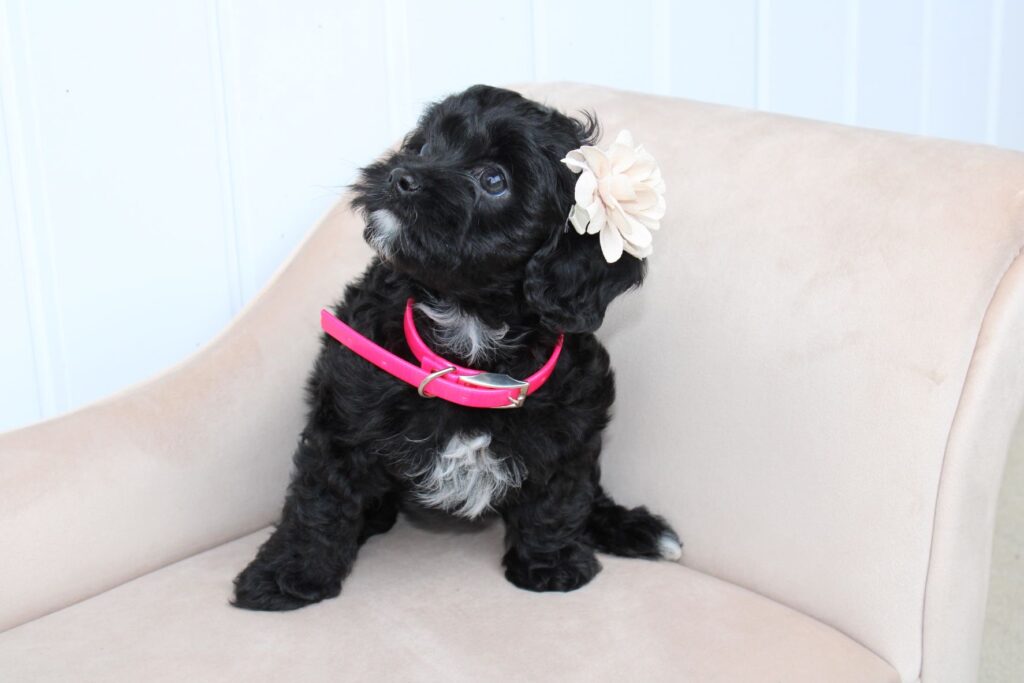
3. Lock Away Cleaning Supplies and Household Chemicals
Cavapoo dogs are naturally curious and will explore everything they can get their paws on, including cleaning products and household chemicals. Many cleaning supplies are toxic to pets, so it’s critical to store them safely.
Tips for Safe Storage:
- Store Chemicals in Cabinets with Childproof Locks: Use locks on cabinets containing chemicals like bleach, detergent, and cleaners. Make sure all cleaning supplies are out of reach of your puppy.
- Use Natural Cleaning Products: Opt for pet-safe, non-toxic cleaning products that won’t harm your puppy if they come into contact with them.
- Be Mindful of Spills: Even after cleaning, keep a close eye on any areas your puppy might explore. Puppies love to lick surfaces, so it’s essential that floors and counters are clean of harmful chemicals.
4. Hide Sharp Objects from Cavapoo Dogs
Sharp objects like scissors, knives, and even certain furniture edges can pose risks to your new puppy. Cavapoo dogs often use their mouths to explore, and they may accidentally injure themselves if they find sharp or dangerous items.
Preventing Accidents with Sharp Objects:
- Store Sharp Objects in High Cabinets or Drawers: Make sure knives, scissors, and other sharp tools are securely stored in cabinets with childproof locks or high shelves.
- Cover Edges of Furniture: Consider using corner and edge protectors on furniture with sharp edges. This is especially important for tables, desks, or low shelves that your puppy can easily access.
- Keep Small Objects Out of Reach: Small, sharp items like pins, needles, and paper clips can also be dangerous. Store them in containers that your puppy cannot access.
5. Prevent Access to Hazardous Foods for Cavapoo Dogs
Cavapoo Dogs have a strong sense of smell and will likely be drawn to food, even if it’s not safe for them to eat. Some common foods are toxic to dogs and can cause immediate harm.
How to Avoid Accidental Poisoning:
- Keep Food Out of Reach: Always keep food on high counters or in cabinets that your puppy can’t access. Puppies are experts at jumping up to snatch unattended food.
- Learn About Toxic Foods: Familiarize yourself with the list of foods that are toxic to dogs, including chocolate, grapes, onions, and certain nuts. Ensure these are never left unattended or within your puppy’s reach.
- Use Lidded Trash Bins: Invest in a trash can with a secure lid to prevent your puppy from rummaging through it and consuming harmful food scraps.
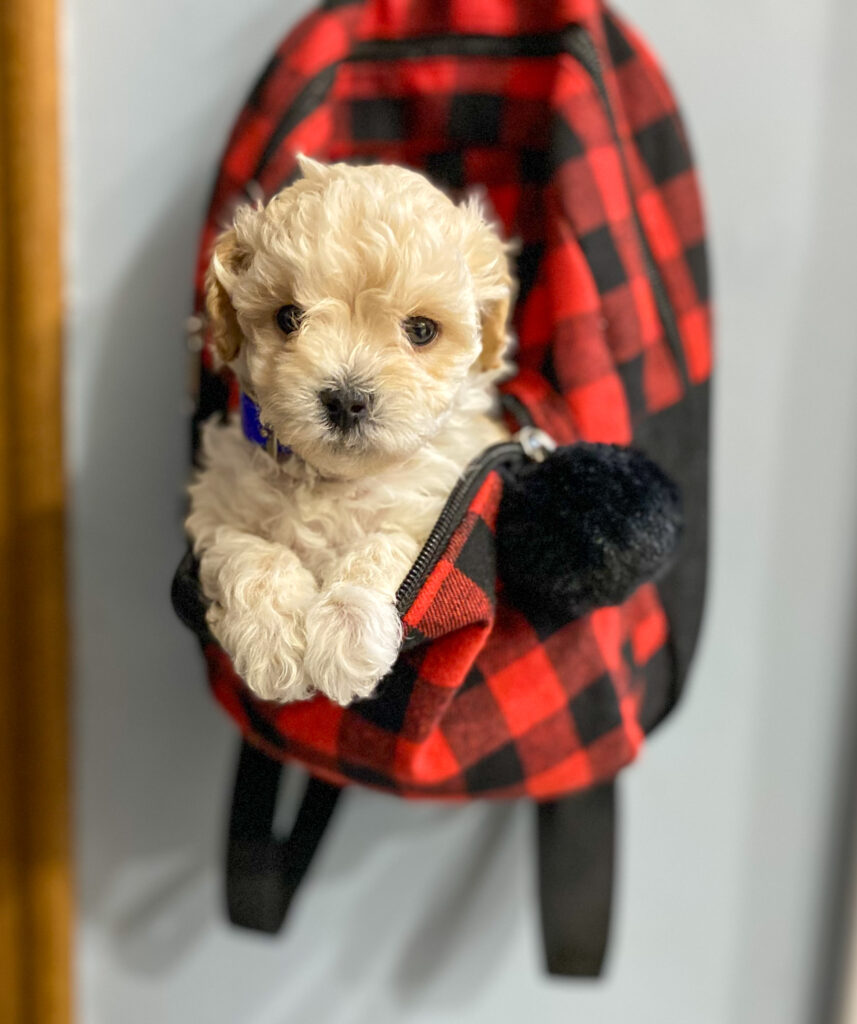
6. Check the Floors and Surfaces
The floors of your home can hide hazards that you may not initially think about. Small items like paper clips, pins, rubber bands, or even pet toys can become choking hazards for your curious puppy.
How to Puppy-Proof Your Floors:
- Thoroughly Sweep and Vacuum: Before your puppy begins roaming around, make sure your floors are free from small items that could be swallowed. Vacuum regularly to remove any hidden hazards.
- Secure Rugs and Mats: Rugs and mats can easily slip, causing your puppy to trip. Secure them with rug pads or double-sided tape to keep them from sliding around. Be cautious of rugs with long fringes that your puppy might try to chew.
- Keep Shoes Out of Reach: Puppies love to chew on shoes, especially those with soft materials or rubber soles. Store shoes in closets or on high shelves where your puppy can’t get to them.
7. Protect Your Furniture from Cavapoo Dogs Damage
Puppies love to chew on furniture, and they have sharp little teeth that can leave behind marks or even cause significant damage. While it’s natural for them to explore their environment, you don’t want to undo your investment in your furniture.
How to Keep Your Furniture Safe:
- Use Pet-Proof Covers: Consider covering your furniture with washable, pet-proof slipcovers or blankets. This makes cleaning up puppy accidents easier and keeps your furniture protected from chewing.
- Provide Chew Toys: Make sure your puppy has an abundance of safe chew toys to keep them occupied. Offering a variety of toys will help satisfy their natural chewing instinct and prevent them from chewing on your furniture.
- Use Puppy Deterrent Sprays: There are sprays available that can deter puppies from chewing on furniture. These sprays often have a bitter taste that discourages chewing.
8. Puppy-Proof Your Yard or Outdoor Area
If you plan to let your puppy outside, make sure the outdoor area is just as safe as your home. Puppies can be curious explorers and might get into trouble if the yard isn’t secure.
How to Make Your Yard Safe for a Puppy:
- Secure Fencing: Ensure your yard is properly fenced, with no gaps or weak spots where your puppy could slip through or dig under. Check the fence for any sharp edges or dangerous materials.
- Remove Harmful Plants: Some plants are toxic to cavapoo dogs. Before letting your puppy roam in the yard, research which plants are safe and which should be removed.
- Avoid Chemical Lawn Treatments: If you treat your lawn with chemicals, wait until the area is dry and safe before allowing your puppy to go outside. If possible, use natural, pet-safe alternatives.
9. Set Up a Routine for your Cavapoo Dogs
Puppy-proofing isn’t just about removing physical hazards. You also need to set up a routine that helps your puppy learn proper behavior and boundaries. Establishing a routine from the start helps your puppy feel secure and understand the structure of their new home.
Creating a Puppy Routine for your cavapoo dogs:
- Potty Breaks: Take your puppy outside frequently, especially after eating, drinking, or waking up. This helps them establish a bathroom routine and reduces the risk of accidents in the house.
- Feeding Schedule: Set regular feeding times to create consistency and help your puppy develop healthy eating habits.
- Training Time: Begin basic obedience training early. Teach your puppy commands like “sit,” “stay,” and “come” to lay the foundation for good behavior.

Puppy-Safe Plants for Cavapoo Dogs
Puppies are naturally curious and love to explore their surroundings, which often includes nibbling on plants. While this behavior can be harmless in some cases, it’s important to be aware that not all plants are safe for your furry friend. Many common indoor and outdoor plants are toxic to puppies and can lead to serious health issues if ingested, ranging from mild stomach upset to more severe reactions such as organ failure or even death. Understanding which plants to avoid and which ones are safe for your puppy is crucial in creating a safe environment for them to explore.
Indoor plants are especially tempting for puppies, who love to chew on leaves and stems. Some of the most common toxic indoor plants include lilies, which can cause kidney failure in cats and dogs, and aloe, which can lead to gastrointestinal issues and lethargy. Pothos and philodendrons are also dangerous, containing compounds that can cause irritation, vomiting, and difficulty swallowing if ingested. On the other hand, there are many pet-safe alternatives that provide a lush, green atmosphere without the risk. Plants like spider plants, areca palms, and Boston ferns are safe for puppies and make excellent additions to your indoor space. These plants not only add aesthetic appeal to your home but also give your puppy something to safely admire without causing harm.
When it comes to your outdoor garden, the stakes are even higher. Many common garden plants, such as azaleas and sago palms, are highly toxic to puppies and can cause severe symptoms like drooling, vomiting, and even liver failure if consumed. Daisies, roses, and sunflowers are great alternatives and can bring vibrant colors to your garden while keeping your puppy safe. It’s also important to keep your garden tidy by regularly cleaning up fallen leaves, berries, or flowers from plants that might pose a danger. Even harmless-looking outdoor plants can be hazardous if consumed in large quantities or if a puppy mistakenly eats a small part of the plant.
To help you easily identify safe versus unsafe plants for your puppy, here’s a helpful chart:
| Toxic Indoor Plants | Pet-Safe Indoor Plants | Toxic Outdoor Plants | Pet-Safe Outdoor Plants |
| Lilies (e.g., Easter lily) | Spider Plant | Azaleas | Daisies |
| Aloe Vera | Areca Palm | Sago Palm | Roses |
| Pothos | Boston Fern | Oleander | Sunflowers |
| Philodendron | Parlor Palm | Rhododendron | Marigolds |
| Dieffenbachia (Dumb Cane) | Bamboo Palm | Foxglove | Lavender |
| Peace Lily | Pilea | Wisteria | Coreopsis |
| English Ivy | Calathea | Foxglove | Zinnias |
Additional Safety Tips:
- Check Plant Labels: Many stores now label plants as “pet-safe” or “toxic to pets.” Always double-check before purchasing.
- Monitor Your Puppy: If your puppy has a tendency to nibble on plants, consider placing your plants in locations they can’t reach, such as hanging baskets or high shelves.
- Educate Your Puppy: Training your puppy to leave plants alone is another essential step in preventing plant-related accidents. Use positive reinforcement to redirect their behavior.
- Know Emergency First Aid: Familiarize yourself with the signs of plant poisoning and keep the contact information for your veterinarian or an emergency pet poison hotline handy in case of ingestion.
By being proactive in choosing the right plants and keeping a close eye on your puppy’s environment, you can ensure that your home is safe and that your puppy can enjoy exploring without the risk of harm from toxic plants.
Secure Windows and Doors
Cavapoo dogs are naturally curious and adventurous, which can sometimes lead them into risky situations if not carefully managed. Open windows and doors, while offering fresh air and a view, can quickly become an escape route for an untrained puppy eager to explore beyond the confines of your home. To prevent such accidents, it’s essential to always keep windows closed or, if you prefer some ventilation, install sturdy screens that can withstand the enthusiastic paws of a playful puppy. This will prevent them from attempting to squeeze through an opening or getting caught in the screen. Sliding doors are another potential hazard, as they are often easy for puppies to nudge open with their paws or noses. Ensure that sliding doors have secure locks in place that are out of reach of your puppy’s curious nature, and double-check the door’s integrity regularly to prevent any malfunction. Additionally, baby gates are an excellent way to create an extra layer of security, particularly when installed in front of exterior doors, such as those leading to your yard or porch. These gates act as a physical barrier that limits your puppy’s access to areas where they might be able to escape. For even more peace of mind, consider using door alarms or motion detectors near any exit points, which will alert you immediately if a door or window is opened unexpectedly. These safety features can help you quickly respond and keep your puppy safe from wandering off or encountering outdoor dangers. By taking these steps, you ensure that your adventurous puppy stays safe and secure while still being able to enjoy the indoor environment freely.
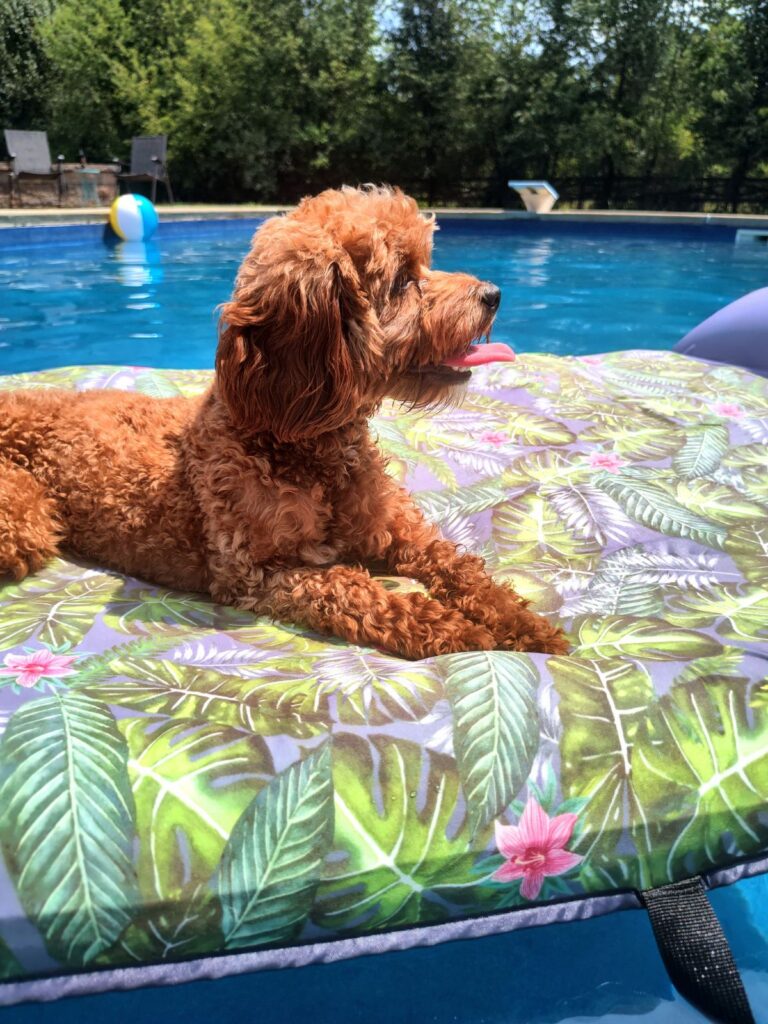
Prevent Drowning Hazards for Cavapoo Dogs
Water sources like toilets, bathtubs, and swimming pools can pose significant drowning risks for puppies, who may fall in while exploring or playing. Always keep toilet lids closed and consider using childproof locks on bathroom doors to limit access. If you have a pool, invest in a secure pool cover or install fencing with a self-closing gate to prevent your puppy from wandering too close. Bathtubs should be drained immediately after use, and water bowls should be placed on stable surfaces to avoid tipping over, ensuring your puppy stays safe around water.
At Storytail Dogs, we understand the importance of early exposure to a variety of experiences, which is why all of our spring and summer litters are introduced to water and swimming before they go home. From gentle splashes to supervised dips in shallow, puppy-friendly pools, we ensure that each puppy becomes familiar with water in a safe and positive environment. This early exposure not only builds confidence but also lays the foundation for a lifelong comfort with water, whether it’s for recreational swimming or therapeutic activities. By fostering these early experiences, we help our cavapoo dogs grow into adaptable companions ready for any adventure with their new families.
You can see our available cavapoo puppies here https://storytaildogs.com/puppies-available
Puppy-Proofing the Garage
Garages can be full of hidden dangers for curious puppies, making it crucial to take extra precautions to ensure their safety. Common household chemicals such as antifreeze, motor oil, and cleaning supplies are often stored in garages, and many of these substances are highly toxic to pets. To prevent accidental ingestion or contact, always store these chemicals in high, locked cabinets or on shelves well out of your puppy’s reach. Additionally, automotive fluids, such as brake fluid or windshield washer fluid, can also pose a significant threat to your puppy’s health if ingested or spilled. Sharp tools, such as hammers, screwdrivers, and saws, as well as heavy equipment like lawnmowers or power tools, can also be dangerous. Always keep these items securely stored in toolboxes or cabinets that can be closed and locked. It’s also important to regularly sweep the garage floor to remove any stray nails, screws, or small debris that your puppy might find and chew on, as these can be choking hazards or cause injury. Another consideration is the garage door—always ensure that the door is fully closed when your puppy is inside, as the space can be an enticing but unsafe playground. Puppies are naturally inquisitive, and the garage may seem like a fun area to explore, but it holds too many potential hazards. For added safety, you might want to restrict your puppy’s access to the garage altogether until they are older, more trained, and better able to navigate the space safely. Taking these preventive steps will help ensure that your puppy can safely enjoy the rest of the house without the risk of injury from garage-related dangers.
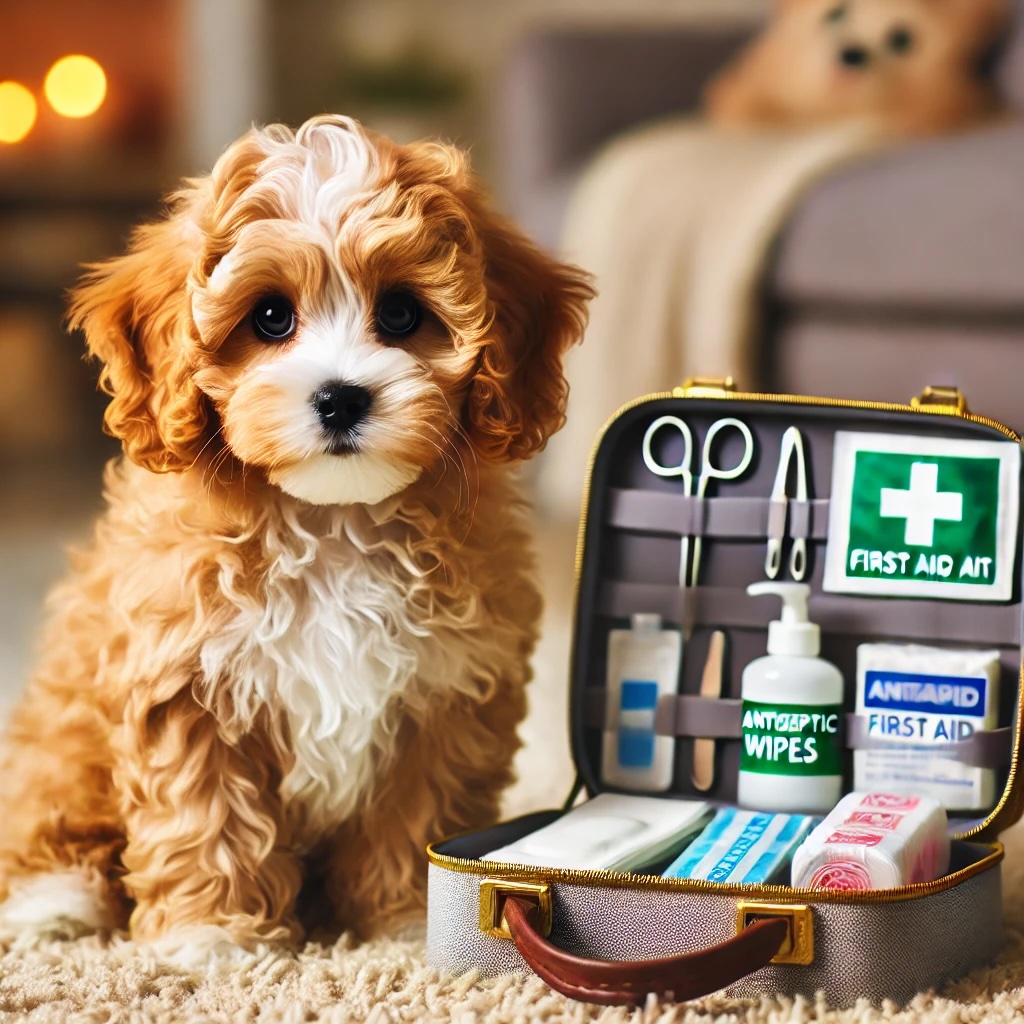
Puppy First Aid for Cavapoo Dogs
Accidents and injuries can happen when you’re least expecting them, especially with a curious and energetic puppy. Whether it’s a small scrape, a minor choking incident, or a more serious injury, knowing how to respond quickly can make all the difference. Understanding basic first aid for puppies is essential for every pet owner. By being prepared and having the right tools on hand, you can handle most situations calmly and effectively until you can get your puppy to a veterinarian.
Choking and Breathing Difficulties
If your puppy is choking on an object, the first step is to assess the situation. If they are coughing or gagging, they may be able to clear the obstruction themselves. However, if your puppy stops breathing or becomes unresponsive, you should immediately attempt to remove the object. Use the “finger sweep” method by opening your puppy’s mouth and carefully using your finger to remove the object if visible. If this does not work, perform the Heimlich maneuver: gently hold your puppy’s body with its head down and compress the chest. Be sure to contact a veterinarian or emergency animal hospital as soon as possible, as choking can quickly become life-threatening.
Cuts, Scrapes, and Wounds:
If your puppy has a minor cut or scrape, the first step is to stop any bleeding. Apply gentle pressure to the wound with a clean cloth or gauze until the bleeding slows down. Once the bleeding is under control, clean the area with warm water and mild soap to remove dirt and bacteria. Be sure to dry the wound carefully. Apply an antiseptic ointment, and then cover the area with a clean bandage to prevent infection. Keep a close eye on the wound for signs of infection, such as redness, swelling, or discharge. For larger or deeper cuts, you should immediately seek veterinary care.
Burns and Scalds:
Burns from hot surfaces or liquids are common hazards for puppies. If your puppy has suffered a burn, first remove them from the source of heat. Rinse the affected area with cool (not cold) water for at least 10 minutes to reduce the temperature and prevent further injury. Avoid using ice, as it can damage the tissue. After the area has cooled, cover the burn with a clean, non-stick bandage and seek immediate veterinary care. In the case of chemical burns, flush the area with cool water for at least 15 minutes and call your vet for further guidance.
Poisoning and Toxin Ingestion:
Puppies are often drawn to chew on things they shouldn’t, and certain household items can be poisonous to them. If you suspect your puppy has ingested something toxic, such as chocolate, plants, or cleaning products, don’t wait for symptoms to appear. Call your veterinarian or an emergency pet poison hotline immediately for advice on what steps to take. In some cases, you may be advised to induce vomiting, but this should only be done under the guidance of a professional. Be prepared to provide information about the substance your puppy ingested, how much, and when.
General Preparedness for Cavapoo Dogs:
Having a well-stocked first aid kit specifically for your puppy is essential for handling emergencies. Your kit should include items such as bandages, gauze, antiseptic wipes, tweezers for removing splinters or ticks, and a thermometer to monitor your puppy’s temperature. It’s also a good idea to keep the contact information for your veterinarian and an emergency animal hospital readily available. By being prepared and knowing how to handle common injuries and emergencies, you can ensure that your puppy is safe and well-cared-for in any situation.
Remember, while basic first aid knowledge is important, nothing replaces professional veterinary care. Always seek medical attention if you’re unsure about an injury or if the situation involves a more serious concern.
Conclusion:
Puppy-proofing your home is an essential part of ensuring your new puppy’s safety during the first few weeks of their life with you. By setting up a safe space, securing potentially dangerous items, and providing proper training and care, you’ll create an environment where your puppy can thrive. Puppy-proofing takes time and effort, but it’s a rewarding process that sets the stage for a positive, happy relationship with your new cavapoo dog. By following these guidelines, you’ll enjoy the excitement and joy that comes with raising a puppy without the stress of worrying about hidden dangers.
American Kennel Club- “Puppy-Proofing Tips for Your Home And Yard”- https://www.akc.org/expert-advice/puppy-information/puppy-proofing-tips-for-your-home-and-yard/
PetMD-“How to Puppy-Proof Your House”- https://www.petmd.com/dog/general-health/how-to-puppy-proof-your-house
American Humane Society-“Pet-Proofing Your Home”-https://www.americanhumane.org/public-education/pet-proofing-your-home/
Leave a Reply Cancel reply
Storytail Dogs
A Dog For Your Story. Focused on READ dogs, therapy dogs, and resilient family companions.
@storytaildogs
© StorytailDogs 2024. All rights reserved. | Legal |